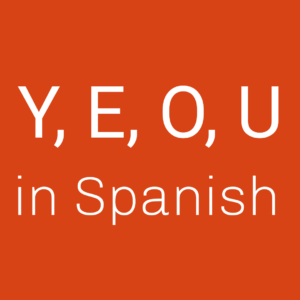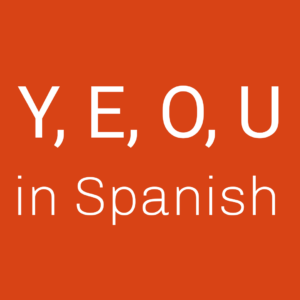Let’s find out what is the difference between y vs e vs o vs u in Spanish.
Study basic grammar rules with online lessons. Read about how and when to use some important words and phrases. When to use Y vs E vs O vs U in Spanish.
What is the difference between Y, E, O, U in Spanish?
Two of the most common conjunctions in Spanish — y (meaning “and”) and o (meaning “or”) — can change spelling and pronunciation based on the word that follows. In that way, they are much like the “a” of English changing to “an”
before a vowel sound. And, like the “a”-to-“an” change, the transformation is based on how the following word is pronounced rather than how it is spelled.
When Do Y and O Change?
Both the y and o changes help keep the conjunction from blending into the following word. (The blending of two words into what sounds like one is called elision when it involves the dropping or omission of sounds, and it is common in both English and Spanish.)
Here are the changes that are made:
·
Y becomes e when it precedes a word that begins with the i sound. Typically, y becomes e when it precedes most words that begin with i- or hi-.
·
O becomes u when it precedes a word that begins with the o sound. Thus o becomes u when it precedes words words starting with o- or ho-.
Because the changes are based on pronunciation rather than spelling, y does not change before words, such as hierba, that begin with the ia, ie, io, or iu sound, regardless of spelling. Those two-letter combinations are known as diphthongs; the initial sounds are very similar to the Spanish “y” sound when “y” comes before a vowel.
Sentences Showing Use of Y and O
Reciben tratamiento cruel e inhumano. (They are receiving cruel and inhumane treatment. The y changes to e because the inhumano begins with the i sound.)
Nuestro conocimiento nos enseña dos cosas claras: posibilidades e imposibilidades. (Our knowledge teaches us two clear things: possibilities and impossibilities. The e is used because imposibilidades begins with the i sound.)
Fabricamos barras e hilos de cobre. (We manufacture copper bars and wires. The e is used because hilos begins
with the i sound even though the first letter is h.)
Está enteramente construido de nieve y hielo. (It is built completely of snow and ice. The y does not change because hielo begins with the ie diphthong.)
Hay un equilibrio osmótico y iónico. (There is an osmotic and ionic equilibrium. The y is used because iónico begins with the io diphthong.)
Hay muchas diferencias entre catolicismo e hinduismo. (There are many differences between Catholicism and Hinduism. The y changes to e because hinduismo begins with the i sound even though its first letter is h.)
Vendemos productos de limpieza e higiene. (We sell cleaning and hygiene products. Higiene begins with the i sound.)
Usamos punto y coma para separar las frases u oraciones que constituyen una enumeración. (We use a semicolon to separate phrases or sentences that make up a list.)
No recuerdo si fue ayer u hoy. (I don’t remember if it was yesterday or today. Unlike with the changes involving y to e, the o changes even though oy is a diphthong.)
¿Qué operador de teléfonos ofrece las tarifas más baratas para viajar a África u Oriente Medio? (Which phone operator offers the lowest costs for traveling to Africa or the Middle East? The rule of changing o to u applies even if the word following is a proper noun.)
La Can Make Similar Change
The desire to keep the sounds of important words from being lost due to elision is also behind the changing of la to el in some circu mstances with feminine sounds. Although there are exceptions, el is used instead of la before singular feminine nouns where the first syllable of the noun is stressed. Thus “the eagle” is el águila even though águila is feminine. The change doesn’t occur with plural nouns or where the stress isn’t on the first syllable. In standard written Spanish, una becomes un (meaning “one,” “a,” or “and”) under the same circu mstances. Thus, “an eagle” is un águila.
These changes and those involving y and o are the only situations where Spanish changes words depend on sounds that follow.
Key Takeaways
– The Spanish conjugation y (meaning “and”) changes to e when the word that follows begins with the i sound.
– The Spanish conjugation o (meaning “or”) changes to u when the word that follows begins with the o sound.
– These changes are triggered by pronunciation only, not how a word is spelled.
Read more about the Spanish Grammar
Popular Spanish categories to find more words and phrases:
A new category where you can find the top search words and phrases translated into English and Spanish. Be an expert in no time!
A new category where you can find the top search words and phrases translated into English and Spanish. Be an expert in no time!
This category has hundreds of words translated into Spanish and English. Just like a dictionary!
This category has hundreds of words translated into Spanish and English. Just like a dictionary!
In this Spanish category, you will find the translation of words and phrases in Spanish, with many sentences that will help you determine how each phrase or word is applied.
In this Spanish category, you will find the translation of words and phrases in Spanish, with many sentences that will help you determine how each phrase or word is applied.
Here are several infographics if you are looking to learn or teach the basic Spanish vocabulary for foreigners. Learn basic Spanish. Videos and resources to learn basic Spanish, Spanish for beginners.
Here are several infographics if you are looking to learn or teach the basic Spanish vocabulary for foreigners. Learn basic Spanish. Videos and resources to learn basic Spanish, Spanish for beginners.
The different verb tenses of Spanish are essential to understanding the language. Find out how to refer to the past, present, and future.
The different verb tenses of Spanish are essential to understanding the language. Find out how to refer to the past, present, and future.
Spanish to Go offers introductory courses you can take to learn Spanish online at your own pace. Whether you are learning Spanish to study or because you want to travel to a Spanish-speaking country. Find online courses to learn grammar, and basic Spanish.
Spanish to Go offers introductory courses you can take to learn Spanish online at your own pace. Whether you are learning Spanish to study or because you want to travel to a Spanish-speaking country. Find online courses to learn grammar, and basic Spanish.
Study Spanish grammar, learn the rules, and know-how and when to apply them.
Study Spanish grammar, learn the rules, and know-how and when to apply them.




